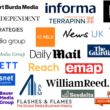We all know it. This can be a golden time for specialist media produced by enthusiasts for enthusiasts. Niche publishers might still lose advertising to Facebook and Google, and copy sales to the free web. But these passionate, focused audiences can become buyers of more than magazines, books and digital information: e-commerce can provide new growth. However, two corporate announcements this month highlighted the divergent fortunes of specialist publishers pursuing e-commerce ambitions in the UK and US.
The UK-based Future Plc announced the acquisition of US digital publisher Mobile Nations. It was the magazine-centric company’s fifth acquisition in 15 months with total spending of some $300m. The latest US deal came as it reported 2018 EBITDA up by 88% and profit margin up from 13% to 17%. E-commerce accounted for $23.1m of revenues and had more than doubled in 2018. Shareholders of the company, founded 34 years ago by TED boss Chris Anderson, love its strategy: the share price has more than trebled in the past 12 months. It is becoming a multi-platform specpub by building proprietary tech, shifting its centre of gravity with targeted acquisitions, and recruiting a senior team of (largely) non-magazine people.
Across the Atlantic, the $90m-revenue F+W Media has a different story. It has been a prominent specialist magazine and book publisher since the 1913 launch of Farm Quarterly and Writer’s Digest (hence F+W). Its “passion” categories now include fine art, crafts, writing, collectibles, genealogy, gardening, woodworking, and astronomy. The company, that must once have been coveted by Future (and vice versa), has grown though a series of acquisitions, including book publishers David & Charles and Krause, Aspire Media, and New Track. In addition to magazines and books, it operates digital services, podcasts, online education, exhibitions – and e-commerce. Its major brands include: Coins magazine, Military Vehicles, Interweave, Quilting Company, Artists Network, Writer’s Digest, Antique Trader, Gun Digest and Popular Woodworking. But it all came crashing down this month as F+W filed for bankruptcy with net debt of at least $105m and a mere $2.5m in available cash. All its assets are now up for sale.
It is less than three years since a debt-for-equity swap cleaned out the company’s former private equity owners and provided what was supposed to be a lifesaving $15m. But it was too little too late and this month’s crash brought to an end the intervening years of asset sales, outsourcing, and 40% redundancies. It had been scrambling to stay afloat. Early explanations were that the company had struggled to compete against cheap (or free) online content but the real problem was a poorly executed e-commerce strategy. As the company began online sales of art, craft and writing supplies, it invested heavily in merchandise, the warehousing to store it, and the tech to manage the whole process. The company now admits: “Unfortunately, these additional obligations came at tremendous cost, both in monetary loss and the deterioration of customer relationships”. The damage was clear: F+W lost no fewer than 36% of its subscribers during 2015-18, while advertising revenue fell by 30%. It now says that the seemingly-expensive technology it purchased for e-commerce operations was either unnecessary or flawed, resulting in customer service issues that caused significant reputation damage. Far from saving the company, e-commerce was the only revenue stream that consistently failed to produce profits: last year, for example, $3m in craft revenues had a $6m cost of sales.
It’s a long way from 2014 (the year, incidentally, when Future’s CEO Zillah Byng-Thorne was appointed). That was when CEO David Nussbaum (now CEO of the high-flying America’s Test Kitchen TV shows) announced that F+W was “strategically moving away from our traditional roots in the media business to focus on its fastest-growing businesses, digital and e-commerce.” F+W was full of optimism and was said to have grown its e-commerce business from one “store” with $6m revenue to 31 “stores” with almost $60m. Nussbaum credited the apparent success to “hiring the right people.” But it is now clear that F+W under-estimated the cost and complexity of its e-commerce.
As a result, many of its larger creditors are those same technologists including Oracle (owed $953k) and Adobe ($695k), and thousands of others including printers and fulfilment companies. F+W never had the expertise or technology to match its ambitions to become a full-service online retailer and this, ultimately, wrecked its relationships with pre-existing print customers. Greg Osberg, the former president of CNET and Newsweek, who became CEO of F+W in 2017, told the bankruptcy court that F+W got almost everything wrong: “The company’s decision to focus on e-commerce and de-emphasise print and digital publishing accelerated the decline of the company’s publishing business, and the resources spent on technology hurt the company’s viability because the technology was flawed and customers often had issues with the websites.”
There’s nothing like bankruptcy for exposing the flaws in a strategy that once looked credible. We are all wiser with hindsight. But the F+W collapse does seem to expose some obvious strategic mistakes. The first point to make is that there is no single model for “e-commerce”. The catch-all term covers a range of online sales activity: from “affiliate” marketing of products on behalf of others (which reader-users click-through to buy from an established retailer), to full-service retailing in which the media company itself buys the stock and takes responsibility for delivery – and all the risk. In between, media can make bespoke arrangements with retailers including sales guarantees, volume incentives, and also provision for “lifetime” commission payments from future purchases by their reader-users.
F+W believed it had the skills and resources to be a full-service retailer and, in the process, managed to damage its pre-existing reader relationships. Media companies have loyal reader-users who depend on them for information, entertainment and a sense of community. But extending that relationship into retailing must include a cool calculation about whether such sales may compromise a media brand’s independence and authority. That may help a media brand to focus on specific products and services, as well as defining the interaction (or not) with editorial content or the brand itself. But, even after satisfying that test, publishers must recognise that operating as a full-service online retailer at scale requires some “non media” resources in order to meet the expectations of customers accustomed to Amazon or ASOS.
That’s where we come back to Future Plc. The UK company itself has had more than its fair share of near-death experiences since it IPOd in 1999 (the year, incidentally, when F+W’s Rosenthal family fatefully sold their third-generation company to investors). But it is now building an increasingly global business where reader-users across tech and hobby markets are fuelling strong growth in e-commerce. It is difficult to know where to begin in contrasting Future’s strategies, proprietary tech and marketing skills with the F+W debacle. But we can start by saying that, for all its profitable growth in affiliate e-commerce, Future doesn’t have warehouses full of things to sell to its reader-users or a distribution chain to deliver them. It now generates almost 20% of revenues from e-commerce (50% of which is through Amazon) but knows it is not a retailer. Go figure.





1 comment